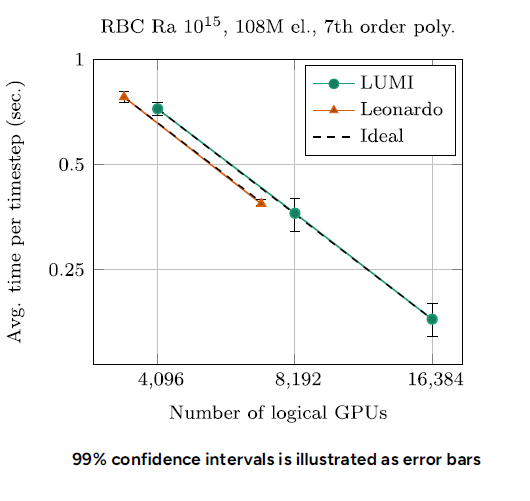A novel Mission in Exascale CFD
The innovation study STRAUSS, short for “Scalable Task-Parallel Multigrid Solvers” is led by Dr. Niclas Jansson from KTH Royal Institute of Technology and aims to develop highly scalable algorithms to handle the computational challenges posed by exascale systems, particularly for Computational Fluid Dynamics (CFD). Through innovations in parallelism and algorithmic efficiency, the project aims to unlock the potential of European supercomputers like LUMI and Leonardo.
Dr. Jansson gave an insightful interview with, focusing on the project’s goals, motivations, and potential impacts on scientific and industrial applications.
A Vision for Extreme CFD
The focus of the STRAUSS project lies in CFD simulations. Dr. Jansson explains that the primary goal is to enable extreme-scale simulations of turbulent flows using innovative algorithms integrated into the Neko solver, developed under the EuroHPC projects CEEC and EXCELLERAT P2. “The motivation for STRAUSS,” he states, “is to extend the scalability of current CFD methods, allowing for large problem sizes without the inefficiencies that typically come with such computational loads.”
CFD is particularly suited for exascale due to its ability to continuously add more grid points, thereby enhancing the resolution of simulations. “We’ve seen a clear need in CFD for more scalable solutions because it’s one of the few fields that can truly take advantage of exascale resources by solving larger, more complex problems,” Jansson notes.

Neko: A Strategic Choice
The selection of Neko as the foundation for STRAUSS was driven by its highly efficient algorithms and its proven ability to scale well on modern hardware, especially accelerators such as GPUs. “Neko has all the algorithmic motifs we need to run big simulations efficiently,” Dr. Jansson explains. “We’re able to take smaller problem sizes and scale them up to entire exascale machines while maintaining computational efficiency, which is crucial for the kind of high-fidelity simulations we’re aiming for”.
Neko is a computational framework specifically designed for high-fidelity spectral element simulations, which play a vital role in CFD. Developed with a modern object-oriented approach in Fortran 2008, Neko excels in efficiently utilizing different hardware backends, from general processors to advanced accelerators like GPUs and even exotic vector processors. This flexibility is key to the STRAUSS project, allowing it to tackle the demands of exascale computing without needing to re-engineer the entire code for each hardware platform.
Neko’s strength lies in its ability to perform Direct Numerical Simulation (DNS) of fluid flows, a method that computes solutions for every geometric point in a flow, providing incredibly detailed insights into turbulence. By benefiting from Neko’s tensor-product operations and mesh generation techniques, STRAUSS can simulate turbulent flows with billions of degrees of freedom, optimizing performance while reducing time-to-solution.
Neko’s matrix-free spectral element method, combined with task-parallel multigrid solvers, enables it to perform well even with the deep memory hierarchies and heterogeneity characteristic of modern exascale systems. These features make Neko an ideal platform for STRAUSS’s innovation efforts.
Scaling the Heights of Supercomputing
According to Dr. Jansson, one of the main challenges in achieving efficient scalability on exascale machines is to keep accelerators like GPUs fully utilized, especially when the problem size becomes small. “As we scale out, the problem size decreases, and the challenge is to keep the scaling and performance good at that point. STRAUSS focuses on addressing this core issue by ensuring that even small-scale problems can utilize the full potential of GPUs,” he says.
This is achieved through novel task-parallel formulations of multigrid solvers, which exploit GPU-specific communication methods to minimize CPU involvement. As Jansson explains, “Our goal is to decouple communication from the CPU, enabling the GPU to handle data movement directly. This eliminates frequent synchronization delays and allows for continuous scaling, even with fewer elements per GPU”.
Key Innovations and Expected Impact
The primary innovation in STRAUSS revolves around task-parallel multigrid solvers that use GPU-initiated communication. This approach not only improves the computational efficiency of solvers but also reduces the required problem size for strong scalability. Early results on machines like LUMI have been promising, with STRAUSS demonstrating close to perfect parallel efficiency even with fewer than 7,000 elements per GPU.

Dr. Jansson highlights that the potential impact of these innovations extends far beyond academic research. “The algorithms developed in STRAUSS are not limited to Neko or even CFD. Any scientific or industrial application that solves large linear systems can benefit from this technology,” he notes. Fields like climate modeling, biomedical simulations, and industrial CFD, such as aerospace or energy applications, could see significant improvements in both time-to-solution and energy efficiency.
The Future of Scalable Simulation
When asked about the long-term benefits of STRAUSS, Dr. Jansson envisions widespread adoption of the techniques developed in the project. “One of the biggest impacts will be on industries that rely heavily on high-fidelity simulations, such as the automotive and aerospace sectors. By reducing the computational cost and time for running large-scale simulations, STRAUSS has the potential to advance how these industries design and optimize their products,” he says.
Moreover, the project aligns with broader goals in energy efficiency and environmental sustainability. As Dr. Jansson notes, “More efficient CFD simulations can contribute to better designs for fuel-efficient aircraft or optimized wind turbines.” These advancements, in turn, could play a role in reducing CO2 emissions and combating climate change on the long run.
Advancing HPC with STRAUSS
Through its integration with Neko and its ambitious goals of improving scalability, reducing time-to-solution, and enhancing energy efficiency, STRAUSS holds the potential to make an impact across multiple scientific and industrial fields. As Dr. Jansson puts it, “We are not just developing better algorithms; we are enabling the future of computational science on the largest scales possible”
